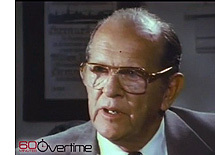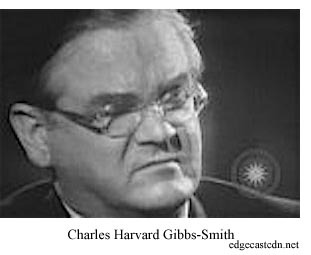 Whitehead advocate, researcher and author, USAF Reserve Major William J. O'Dwyer was a driving force in the attempt in the late 1960's and the 1970's to have Gustave Whitehead recognized as being the first human to fly.
Whitehead advocate, researcher and author, USAF Reserve Major William J. O'Dwyer was a driving force in the attempt in the late 1960's and the 1970's to have Gustave Whitehead recognized as being the first human to fly.
Advocates for the Whitehead claims state that Gustave Whitehead (born 1874 in Germany as "Gustav Weisskopf") flew in a machine he built (his "No.21") on August 14, 1901, nearly two years prior to Wilbur and Orville Wright's history-making flights on December 17, 1903. The great majority of aviation historians find the Whitehead claims utterly lacking believable supporting evidence.
O'Dwyer co-authored the pro-Whitehead book "History by Contract" (1978) with pioneer Whitehead advocate, researcher and author Stella Randolph ("Lost flights of Gustave Whitehead 1937"; "Before the Wrights Flew: The Story of Gustave Whitehead 1966"; and co-author "History by Contract" 1978).
For well over a decade, O'Dwyer and Randolph together were the leading advocates actively supporting the "first in flight" claims made by and for Gustave Whitehead, while Randolph's endorsement of the Whitehead claims dated back to the mid-1930's.
 All of which makes O'Dwyer's June 7, 1966, letter to famed British aviation historian and significant Whitehead critic, Charles Harvard Gibbs-Smith, all the more surprising and striking.
All of which makes O'Dwyer's June 7, 1966, letter to famed British aviation historian and significant Whitehead critic, Charles Harvard Gibbs-Smith, all the more surprising and striking.
In 1966, O'Dwyer stated that he did not believe Whitehead's claims of having made a half-mile flight in 1901 and a 7-mile (circling and over water, no less) in 1902.
"For my money, it never made a 1/2 mile or a 7 mile flight. I do however feel it made some short flights."
O'Dwyer's notion of "some short flights" involves short low hops off the ground, not "flights" as are generally understood.
O'Dwyer proposed wind tunnel testing of a modern 'replica' of Whitehead's No. 21, to determine if that machine could have flown. Of course, without also utilizing the powerplant and propellers and other elements of the original, any modern 'replica' only broadly simulates that original, and, hence, only hints but does not answer the question whether the original No. 21 could have flown.
Over the years since 1966, two modern-day renditions of No. 21 have been built and tested, one by Andrew Kosch (the "No.21A") and one in Germany (the "Nr.21B" built by the "Historical Flight Research Committee Gustav Weisskopf" - "HFRC-GW"). Both have surface areas close to the original's published value of 450 sq. ft., yet allocate the surface areas between wings and tail differently.
The differences in surface area between the two modern versions and the original No. 21 call into serious question the results of tests of the modern No. 21-type machines. The total surface area of an aerial machine is a major factor of whether or not that machine will lift off and fly, other factors being lift and angle of incidence of the aerofoil used, total weight, total head resistance and thrust, among other factors.
The German Nr.21B used modern flight controls and employed a modern hi-revving engine and modern efficient "toothpick" propellers, as well as having many additional wires and other improvements and strengthening in construction not found on the original Whitehead No.21. Also, notably, the German Nr.21B had yaw and roll control not found on the original No.21.
The Kosch No.21A also utilized a modern hi-revving engine and "toothpick" propellers, as well as modern flight controls.
Data derived from testing No. 21A and most especially the Nr.21B machine, with its many modifications based on modern understanding of structures and aeronautics, should be considered provisional. The free-flights of No. 21A and the Nr.21B are not evidence that the original No. 21 made controlled, powered flights in 1901 or at any time.
O'Dwyer also draws a distinction between the "flights" of the original Whitehead No.21 - which he discounts - and other elements of the Whitehead story, saying...
"When I first stuck my little toe into this matter, I too had felt that Whitehead was indeed a charlatan. Now that I am in it up to my neck, most of the previous opinions have been proven wrong. This does not include the controversial flights. I speak solely of his overall perspective."
In the same June 7, 1966, letter, O'Dwyer also comments on one of Whitehead's main supporters and associates, Junius Harworth, O'Dwyer states...
"When I began this research, only 6 or 7 pages of typewritten notes were available outside of Stella Randolph's first book. Upon reading the book, I too questioned the veracity of Harworth's statement. However some of his testimony must be accepted, as a thorough research in our Squadron has proven that many of his words were verbatim of the actual events. Not the flights, mind you, but other miscellaneous details."
So, O'Dwyer believes Harworth was not telling the truth about the "flights."
Continuing about Harworth, O'Dwyer writes...
"I have read and re-read all of his correspondence to Miss Randolph. His statements do not have continuity in many areas and from time to time I found that his statements failed to correspond with previous remarks. Harworth in my mind was sincere in his effort to strive for recognition for Gustave Whitehead, but somewhere along the way, he has transplanted himself from just a youth around the shop to a full time partner in his association. Later in his teens (17 to 19) he did aid Whitehead as a form of an associate. But his memory of flights confuses me entirely."
"He was the main errand boy of the 1900-01 shop. He may easily recall various tasks Whitehead might have assigned him to, but as to being a 1st class associate, I cannot buy this at all. In my log I denounced his significance and wrote his testimony off as being un-reliable. This was done some 2 years ago. So basically we agree on this man. However, I reserve one additional remark. Where other research corroborates many of his statements as to details of shop tools, the making of the propellers, the various minute details of some of the #21 aircraft parts etc.., then I do feel that those statements hold considerable merit.. Like Peck's Bad Boy, he wasn't all bad at all."
------------------------
William J. O'Dwyer persisted for many years to gain recognition for Gustave Whitehead's efforts, even though, as can be seen, in 1966 he could not believe the claims of flight that Gustave Whitehead made.
As the discussions regarding Whitehead became more heated and O'Dwyer's position hardened, he pressed on the matter of the original claims of flights in 1901 and 1902 with increasing intensity.
It is of significant historical interest that William O'Dwyer at first discounted the very claims he later promoted with such ferocity. It seems this transition was not a matter of O'Dwyer finding new evidence that the Whitehead flight claims were true, but rather that O'Dwyer became more aggressive and unquestioning as his status of being a main pro-Whitehead advocate became greater.
This psychological phenomena of transitioning to becoming a "true believer" can also clearly be seen in those who have recently become advocates for the Whitehead flight claims. No amount of reasoned discussion and scientific evidence can combat their unreasoning faith.
------------------------
NOTES: A copy of the June 7, 1966, letter from Wm. O'Dwyer to Charles Harvard Gibbs-Smith was located in the restricted access Connecticut Aeronautical Historical Association (C.A.H.A.) archive at the National Air & Space Museum (N.A.S.M.), Washington, DC, accessed by this writer with permission from the organizational descendant of C.A.H.A., consistent with the terms of the restrictions.
This writer was evidently the first person to gain access to the C.A.H.A. material in the N.A.S.M. archive since it was placed there in 1968.
The June 7, 1966, letter was first made public on September 4, 2015, on this writer's Gustave Whitehead - What Did He Do ? web site.
The four-page letter can be viewed HERE
The original of the letter is held within the Charles Harvard Gibbs-Smith archive at the Science Museum Library and Archives, Swindon, England.
Additional Huffington Post articles by this writer on the Gustave Whitehead controversy can be accessed on this writer's Gustave Whitehead - What Did He Do ? web site.
The opinions expressed in this article (other than those contained in the June 7, 1966, letter) are solely those of the writer.
------------------------

